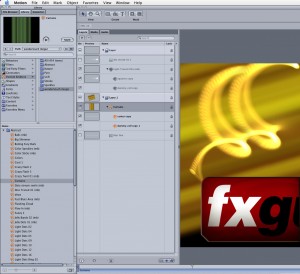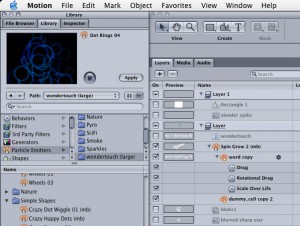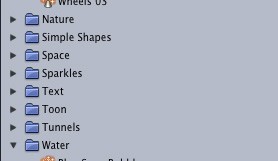We test drive the wondertouch Motion plugins and ask the question – will this help unlock some of the potential of Motion? Why isnt Motion more widely used? Are the Wondertouch plugins worth it? And we ask Wondertouch President Alan Lorence how he came up with the new emitters?
In Sept last year we reviewed Apple’s Motion. At that time we reported that it was one of Apple’s “most eagerly awaited releases since it was first demonstrated back at NAB (04)”. At NAB this year it was updated with Motion 2. At only $299US it seemed like a certain winner, but a year on Motion has yet to live up to its potential. Search the Web – there just doesn’t seem to be a world of Motion work being published or at least talked about. This is to not say the product is a failure, but rather it is yet to have its potential unlocked.
So why is this ?
While Motion has incredibly powerful real time features, it lacks – still with version 2, – a few key aspects,
These include…
• it does not have a 3D compositing environment
• It can’t do high quality roto and it lacks paint features
• it lacks any i/o or direct video controls
• there is a lack of fine detail control of the elements in the project – at least to the level expected by AE users.
• the type tools are just not to the standard you need for broadcast design
• Motion’s particles – while impressive, lack 3D lines, and love it or hate it – a heck of a lot of this type of broadcast design uses 3D lines flying around.
The problem Motion had on introduction was that it was priced really cheaply – thus suggesting it was perhaps not a Pro app, but it only ran on the top of Apple’s then product line, so many users couldn’t use it.
Motion does have some excellent features and its ability to have the motion file incorporated directly into shake and now AE is a great reason why Motion is used sucessfully in conjunction with other programs. While there is little in the way of hard data, it appears most designers use Motions very powerful particle system to make a elements which are then incorporated with other 3D and 2D elements.
If Apple continues with Motion – it could become the amazing tool we all know it can be, until then it is often best used creating cool elements…

Which brings us to Wondertouch’s Motion plugins.
These plugins provide a set of new functionality but by using Motion’s own built-in particle system.
To cut a long story short – if you use Motion – you’ll want these plugins. Wondertouch extends Motion by providing some excellent ( and a few naff) new emitters. Wondertouch produce a great set of new looks, some of which seem to pull off things such as trailing lines, that Motion simply isn’t meant to be able to do.
Motion’s particle system is similar to particleIllusion SE, but SE has some features that Motion’s system does not (the ability to change particle velocity over life and spin over life for example). ParticleIllusion SE is the particle system used in Combustion, (note the same version of Particleillusion is used in both Combustion3 and Combustion4). This it is that Wondertouch knows a lot about motion graphics particle systems. Wondertouch is not without its limitations – while the steam, smoke and cloud effects are good, they to not rival the sort of feature film quality you can achieve from some 3D packages. Rather Wondertouch is ideally placed for producing fast and interactive effects – exactly the sort of particle effects you might want in a motion graphics system.

We spoke to Alan Lorence President of Wondertouch LLC.
FXG: How did you develop these new plugins?
AL:”I’ve been creating particle emitters using particleIllusion since ’99. In the last couple of years I’ve gotten pretty good at it (if you don’t mind me saying so), as would be expected after 1000 emitters or so. My “secret” to creating great, interesting, artistic emitters is to NEVER start from scratch; always start with an existing emitter and modify it. That’s how I create 95% or more of my emitters (I’ll only start with a blank emitter once in a while as an exercise).”

FXG: And just how did you get those glow line type particles?
AL: “When I was converting the particleIllusion emitters to work in Motion, only about 25% of the emitters could be converted. Some of them worked great in Motion right away (after conversion), others took some tweaking to get looking right or performing well, and some just would never look right even after several minutes of tweaking. It was during one of the tweaking sessions that I stumbled upon the “light trail” or “ribbon” emitter effect. I’m pretty sure that I played around with an emitter that I just couldn’t get looking right, and then noticed a rough version of the “ribbon” emitter. Some more tweaking, and I got it looking smooth. I remember that I wanted to look at the parameters (something I don’t usually do) and see exactly how I got it to do that sort of effect. I also remember not understanding how it worked the way it did.”
FXG: Do you have an approach to the way to went about them?
AL: To be honest, I rarely develop emitters from a “logical” approach. I don’t look at “how” I’m getting the visual results — I just keep modifying until I find something “cool”.
FXG: How much is the particles for Motion?
AL: We have 3 sizes available. The full set is 335 emitters for $149.
We also offer smaller subsets of 200 emitters for $99, and 65 emitters for $39.
FXG: Have they been tested with the MIDI inteface of motion 2?
AL: Since they use Motion’s built-in particle system, if Motion 2’s particles work with the MIDI interface, then “yes”.
More info at:
Wondertouch website
